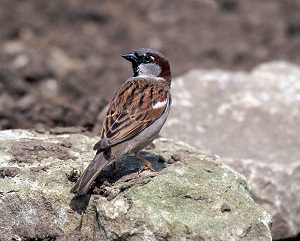Using citizen science to investigate the role of productivity in House Sparrow Passer domesticus population trends
Catriona A. Morrison, Robert A. Robinson, Dave I. Leech, Daria Dadam & Mike P. Toms (2014)
Bird Study 61: 91-100
House Sparrow by Jill Pakenham.
Abstract:
Capsule Seasonal variation in garden House Sparrow numbers provides a tool to examine overall annual productivity, measuring the combined success of multiple breeding attempts and post-fledging survival.
Aims To develop a metric to use British Trust for Ornithology (BTO) Garden BirdWatch (GBW) data to measure annual productivity in House Sparrows across regions and habitats exhibiting contrasting population trends.
Methods We examine variation in annual productivity by quantifying the height of the seasonal peak of garden House Sparrows relative to pre-breeding numbers. We use BTO Nest Record Scheme (NRS) data to explore the demographic drivers of variation in this metric and relate differences to BTO/Joint Nature Conservation Committee/Royal Society for Protection of Birds Breeding Bird Survey regional population trends.
Results GBW annual productivity was similar between rural and urban gardens but was lower in the south and the east of Britain (1.32 fledglings per adult), where populations are declining, than in the north and west where populations are stable (1.37 fledglings per adult). Analysis of NRS data showed similar regional variation in clutch and broods sizes.
Conclusion The intensity of effort required to measure breeding success directly through nest monitoring has limited the scale of data collection but these results suggest that Garden BirdWatch (GBW) data can provide a measure of annual productivity across multiple sites. Regional variation in annual productivity (primarily driven by reduced clutch sizes) mirrors population trends, suggesting that reduced breeding success may be influencing House Sparrow population recovery.







Share this page